SNL’s Musical Guests
For nearly four decades, Saturday Night Live has been a showcase for musical talent, ranging from living legends to up-and-coming artists, one-hit wonders, and singers and bands of whom you’ve never heard. No matter how many gold albums hang on their wall or Grammy statues sit on their shelf, at approximately 12:10 a.m. and 12:50 a.m. they will all stand front and center on the same stage in Studio 8H and perform in front of a live audience.
In a special issue of Spin magazine (February 1993) guest edited by the folks at SNL, John Zonars, the show’s musical coordinator, emphasized the significant role Saturday Night Live has played in keeping live music alive: “SNL is perhaps the most accurate barometer of what’s hot and what’s not in music. It doesn’t matter if you’re a three-piece band such as Nirvana or a forty-two-piece orchestra backing Sinéad O’Connor—when you get that cue from the stage manager, you’re going live in front of millions of Americans. There’s no chance to remix, no opportunities for a second take.”
When SNL debuted in 1975, live musical performances were a thing of the past. Variety shows were taped in front of a live audience. The last “really big show” to feature live performances, The Ed Sullivan Show (1948–1971), had been off the air for four years. In the 1960s, Sullivan hosted big names like the Beatles, Elvis Presley, the Doors, the Rolling Stones, the Band, the Mamas and the Papas, and Janis Joplin. Unfortunately, the Beatles did not take Lorne Michaels up on his offer of $3,000 to reunite on SNL (1.18). According to Lennon’s biographer Philip Norman, Lennon and McCartney were uptown in Lennon’s apartment in the Dakota watching the show that night and considered taking a cab to 30 Rock and making a surprise appearance, but decided against it. The Rolling Stones did perform live from 30 Rock in 1978 (4.1), along with the Band (2.6), the Grateful Dead (4.5, 5.15), and Bob Dylan (5.2), who walked off The Ed Sullivan Show during rehearsals when, as the legend goes, CBS Standards and Practices refused to allow him to sing “Talkin’ John Birch Paranoid Blues” because it equated the right-wing group to Hitler.
According to Hill and Weingrad’s backstage history of the show, in the beginning Lorne Michaels had the “sole responsibility” of choosing the host and the musical guest. One of the show’s talent coordinators characterizes Michaels’s selection process back then as “unbelievably arbitrary” and not based on if they had recently released a studio or “Best of” album and, if they did, where it ranked on the Billboard Chart. In the February 1993 issue of Spin magazine, Michaels explained to editor Bob Guccione Jr., “In ’75, when we were starting, it was rare to have this kind of music on television, so it was enough that people who didn’t perform on television came on. . . . We weren’t booking from the charts. . . . By presenting music in a very straightforward way, people began to trust us and certain people volunteering to come on gave us a certain credibility.” This explains the eclectic lineup of artists who appeared in season 1: jazz singer Betty Carter, Canadian country/pop singer Anne Murray, ABBA, Rita Coolidge, Patti Smith Group, Neil Sedaka, Leon Redbone, Al Jarreau, Janis Ian, John Sebastian, Loudon Wainwright III, Gil Scott-Heron, and Carly Simon. Still, many of these artists did perform songs off of their most recent studio or “Best of” album, and some of them also had a single on the Billboard Chart.
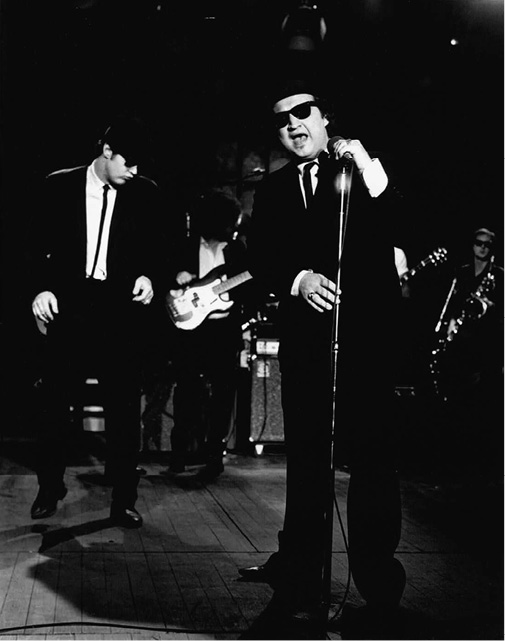
The Blues Brothers perform “Soul Man” (4.6).
There’s no question the national exposure SNL gives an artist or band can help boost album sales. Many artists have seen significant jumps in their album and singles sales immediately after their performance on SNL. According to a 2010 study by Terry Tompkins published in the Journal of the Music & Entertainment Industry Educators Association, artists performing on SNL experience a 35 percent increase in sales. Tompkins cites as a test case study the appearance of British singer Adele on SNL on October 18, 2008 (34.5). She sang two songs from her album 19: “Chasing Pavements” and “Cold Shoulder.” Also appearing on the same show, hosted by Josh Brolin, was Republican vice-presidential candidate Sarah Palin. Approximately seventeen million viewers tuned in, making it the most watched episode of the season. According to the Hollywood Reporter, the show’s overnight ratings (10.7/24 in metered markets) were the highest since Nancy Kerrigan hosted in 1994 (19.15). After her appearance, Adele’s album sales increased by 132 percent in the United States. During the week after her performance, 19 sold 24,926 units, an increase of 14,000 from her previous top-selling week of 11,850. Tompkins points out that in addition to having higher ratings than the daily weeknight talk shows like The Late Show with David Letterman (1993–present) and Jimmy Kimmel Live! (2003–present), SNL guests get to sing two numbers and benefit from the on-air promotion leading up to their appearance.
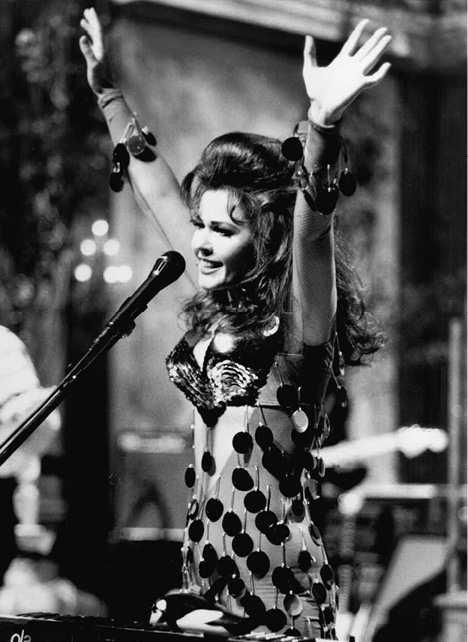
The B-52s’ Kate Pierson performs “Cosmic Thing” in the band’s 1990 appearance (15.18).
Some artists have pulled double-duty as both the musical guest and the host. Although they were billed as the show’s host, three performers—Paul Simon (1.2), Lily Tomlin (1.6), and Desi Arnaz (1.14)—did this during the show’s first season. Paul Simon was the first in the show’s history (1.2), with Randy Newman and Phoebe Snow as his musical guests and Art Garfunkel as his “special guest.” Except for a filmed segment in which he plays a game of one-on-one with NBA star Connie Hawkins, Simon spends most of his airtime behind a microphone singing (alone, with Garfunkel, and then Snow). When he returned to host the show, he performed with George Harrison (2.8), Ladysmith Black Mambazo (11.16), and Linda Ronstadt (13.8). In addition, Simon has been a musical guest eight times between the years 1977 and 2011 and has made numerous cameo appearances. Additional hosts who’ve worn both hats include Justin Bieber (38.13), Garth Brooks (23.14, 25.5) (his musical guest was his alter ego, Chris Gaines), Ray Charles (3.5), Hammer (17.8), Janet Jackson (29.17), Mick Jagger (37.22), Elton John (36.18), Jon Bon Jovi (33.3) (who also featured the Foo Fighters), Jennifer Lopez (26.11, 35.15), Ludacris (32.6), Bruno Mars (38.5), Willie Nelson (12.12), Olivia Newton-John (7.20), Dolly Parton (14.17), Queen Latifah (30.2), the Rolling Stones (4.1), Britney Spears (25.19, 27.12), Sting (16.11), Taylor Swift (35.5), Justin Timberlake (29.2, 32.9, 38.16), Stevie Wonder (8.19), and Frank Zappa (4.3). Interestingly, most, but not all, of them had previous acting experience on television and in feature films.
Why God Created Live Television
Simon & Garfunkel, “The Boxer,” “Scarborough Fair,” and “My Little Town” (1.2)
In a promo on the premiere episode of SNL, next week’s host Paul Simon invites everyone to tune in to see Phoebe Snow, Randy Newman, and his “ex-partner, Art Garfunkel, for a little Simon & Garfunkel reunion.” When Garfunkel joins Simon onstage the following week, they get a standing ovation. After Simon kids Garfunkel about “crawling back” and his movie career, they sing—in perfect harmony—“The Boxer,” “Scarborough Fair,” and their new single, “My Little Town,” which appears on their respective solo releases, Simon’s Still Crazy After All These Years, and Garfunkel’s Breakaway, which were both released that month. There was so much press surrounding their breakup, no one imagined we would ever see them sharing a stage again. Considering this was show 1.2, it was a major coup for SNL.
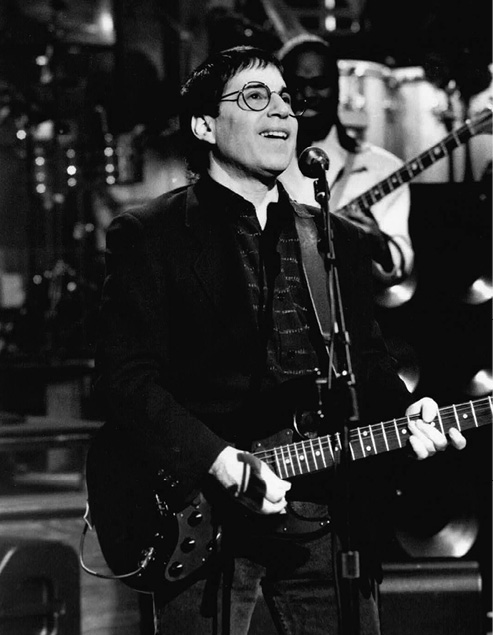
Between 1977 and 2011, Paul Simon has been a musical guest on SNL eight times.
Patti Smith Group, “Gloria” and “My Generation” (1.17)
In season 1, when SNL was still a little raw and rough around the edges, “Godmother of Punk” Patti Smith traveled uptown to make her television debut and introduce punk rock into America’s living rooms. Unless they frequented CBGB, the East Village club that at the time was the center of the New York underground music scene, they probably never heard anything like Smith’s rendition of Van Morrison’s “Gloria” and the Who’s “My Generation,” which were on her 1975 album Horses. Hosting the show that evening was Ron Nessen, the press secretary to President Gerald Ford, which means there’s a chance he was tuning in that evening also (see also chapter 15). Smith was the inspiration for Gilda Radner’s punk rocker Candy Slice, who made her debut in season 4 (4.8).
Elvis Costello and the Attractions, “Radio, Radio” (3.8)
Elvis Costello stole some of the limelight away from the week’s guest host, eighty-year-old Miskel Spillman, winner of the first and only “Anyone Can Host” contest, when thirty seconds into his second number, “Less Than Zero,” he stopped the band and said, “I’m sorry, ladies and gentlemen, there’s no reason to do this song here.” He then launched into “Radio, Radio” from his forthcoming album, This Year’s Model, which is critical of the radio and music industries. In a 1989 Rolling Stone article commemorating the show’s fifteenth anniversary, Costello explained he and his band knew they were not the first choice as the evening’s musical guests (the Sex Pistols had visa problems and couldn’t travel to the United States), and he was not impressed with the atmosphere around the show. They decided to do what Jimi Hendrix did when he was a guest on a British television series and switch songs at the last minute. Considering this a form of improvising (as songs are rehearsed for the camera), Michaels was reportedly furious and banned Costello from the show, though he was invited back in March 1989 (14.15) and again in 1991 (16.20). Costello also appeared on the SNL 25th Anniversary Special in which he interrupted the Beastie Boys’ number, and together they sang “Radio, Radio.”
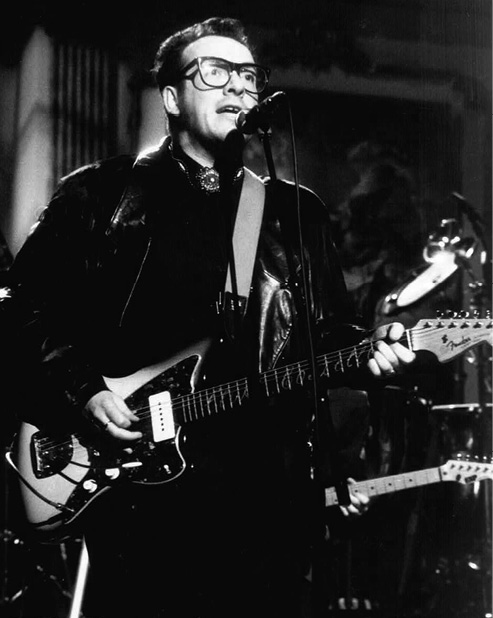
After reportedly being banned from the show, Costello returned in 1989 to sing “Veronica” and “Let Him Dangle” (14.15).
Fear, “I Don’t Care About You,” “Beef Bologna,” “New York’s Alright If You Like Saxophones,” and “Let’s Have a War” (7.4)
The punk band Fear were the musical guests on the 1981 Halloween show. The host was British actor Donald Pleasence, best known to young audiences as Dr. Sam Loomis in Halloween (1978) and the sequel, Halloween II (1981), which was released in theaters the previous night. Unlike the performers and bands that appear on SNL, Fear had not yet released an album (their first, The Record, was released in 1982). But they had a loyal fan base within the punk rock world and gained national exposure when they appeared in Penelope Spheeris’s documentary about the Los Angeles–based punk rock scene, The Decline of Western Civilization, which was released in the summer of 1981. John Belushi was a fan, and he had lobbied to use their music for the soundtrack of what would be his last film, the black comedy Neighbors, costarring Dan Aykroyd. But the studio didn’t go for it, so to make it up to the band he convinced Dick Ebersol, with the support of Michael O’Donoghue, to feature them on SNL. Only they didn’t come alone.
Fear’s fans from Washington, D.C., described by the press as “Skinheads” (rockers with shaved heads), were bused to New York to appear on the show so they could “stage dive” (literally running up to the stage and diving off into the crowd) and slam dance, a style of dance in which the participants push and slam into each other with their bodies. Despite how it looks on camera, slam dancing is not intentionally violent, though it has resulted in serious injuries and even some fatalities. As a result, slam dancing (or as it is known today, “moshing”) is prohibited today in some venues.
Their first set, in which they sing “I Don’t Care About You,” is like any other SNL musical performance. It’s during their second set, in which they sing “Beef Bologna,” “New York’s Alright If You Like Saxophones,” and “Let’s Have a War,” that the stage is surrounded by mostly white teenage boys who slam dance and dive off the stage. Someone yells out, “New York Sucks,” and by the time they get to the third song, the crowd is even more unruly. Ebersol tells director Dave Wilson to cut to a film (“Prose and Cons” from the season opener).
“‘Fear’ Riot Leaves Saturday Night Glad to Be Alive” read the New York Post headline the following Tuesday. According to Billboard magazine, the Post reported that the band and their fans caused “an estimated $200,000” in damages to a Mini-cam camera, two viewers, a viewing room, and the Green Room. They described Fear’s performance as a “total out of control free-for-all” in which the band’s fans “jumped up and started slamdancing—a new punk craze that involves dancing, biting, and kicking.” The Post article also said that “all hell was breaking loose with the affiliates” because of obscenities shouted during the performance. The Billboard story included a quote from Saturday Night Live spokesman Pete Hamilton, who claimed that the New York Post “did not check its facts, and . . . chose to print an erroneous story. As far as we can tell there has been no $200,000 in damages. We had to pay $40 in labor penalties.”
Billboard interviewed the band’s frontman, Lee Ving, and Robert Biggs, president of Slash Records, who said there was a problem during dress rehearsal when one of the kids tripped over a camera cable. The cameraman refused to work under these conditions, but Ebersol convinced him to return to work. Ving also explained that “the band wanted their audience so they wouldn’t be playing to a bunch of blockheads, so they called down to Washington. In New York there really isn’t the scene, but it remains viable in suburban areas. So they went to Washington and imported a bunch of skinheads.”
One aspect of the performance Billboard doesn’t mention is the tension in Studio 8H between the punk rock fans and SNL’s studio audience. In an interview with PUNKHOuseTV entitled “John Belushi Was a Punk Rocker,” John Joseph, of the punk rock band ProMags, was part of the slam-dancing crowd that night. He described how the crowd bused in from Washington, D.C., tore up the Green Room (and pulled the strings right out of the piano). When it was time for them to appear on camera, they were not only slamming into one another, but were diving on top of the audience members. A fight broke out between the D.C. and New York people. When Fear was finished, the fighting continued, and when the head of security stood on the stage and tried to clear everyone out, someone hit him in the head with a pumpkin.
In exchange for allowing the slam-dancing fans to participate, Belushi agreed to do a cameo on the show. He appears in the cold opening, in which a nervous Pleasence gets advice from Eddie Murphy, who shares with him what all the cast members do before each show—vomit. When Eddie leaves, Pleasence puts his finger down his mouth and rushes into a stall. Out of the next stall comes John Belushi, who lifts his hat and fixes his hair in the mirror. The audience goes wild. Acting as if he suddenly realized where he is, Belushi exits. It would be Belushi’s last appearance on SNL.
The Red Hot Chili Peppers Perform “Under the Bridge” (17.14)
The Red Hot Chili Peppers sounded like a wasted garage band performing their hit single “Under the Bridge.” In his autobiography, Scar Tissue, Anthony Kiedis admits singing the song live is a challenge and that he depends on guitarist John Frusciante for the music cues in the introduction to the song. “I had no idea what song he was playing or what key he was in. He looked like he was in a different world,” Kiedis writes. “I felt like I was getting stabbed in the back and hung out to dry in front of all of America. . . .”
Sinéad O’Connor’s Declaration of “War” (18.2)
Irish singer Sinéad O’Connor was scheduled to make her first appearance on Saturday Night Live on the second-to-last show of the fifteenth season (15.19). When controversial comedian Andrew Dice Clay was announced as the guest host, O’Connor, along with cast member Nora Dunn, boycotted the show because of the sexist and derogatory nature of Clay’s comedy. Variety reported that O’Connor made her decision after watching some of his routines on video. Through her publicist, she explained, “I feel it shows disrespect of women that ‘Saturday Night Live’ expected me to perform on the same show as Andrew Dice Clay.” O’Connor finally did appear on the season 16 opener with a noncontroversial host, actor Kyle MacLachlan. She performed “Three Babies” and “The Last Day of Our Acquaintance” from her 1990 album I Do Not Want What I Haven’t Got.
Two years later, O’Connor made her second and presumably last appearance on SNL. On October 3, 1992, hosted by Tim Robbins (18.2), she sang “Success Has Made a Failure of Our Home” from her new album, Am I Not Your Girl? For her second song of the night, O’Connor sang a haunting a cappella version of “War,” by Jamaican singer/songwriter Bob Marley.
Marley was a follower of the Rastafari movement, which hailed Ethiopian minister Haile Selassie I (1892–1975) as the Messiah. The lyrics to Marley’s song were excerpted from a famous speech delivered by Selassie to the United Nations on October 6, 1961. Selassie, an advocate for peace, call for the disarmament of nations “because of the immense destructive capacity of which men dispose.” Marley immortalized a part of the same speech in which he talks about how the “African continent will not know peace” until racial inequality is “finally and permanently discredited and abandoned . . . until there are no longer first class and second class citizens of any nation . . . until the color of a man’s skin is of no more significance that the color of his eyes . . . until the basic human rights are equally guaranteed to all without regard to race . . . We Africans will fight, if necessary, and we know that we shall win, as we are confident in the victory of good over evil.”
Marley’s song and Selassie’s words were used by O’Connor to wage a different kind of war—against child abuse. She substituted the line “fight racial injustice” with “fight sexual abuse,” and in the dress rehearsal she held up a photograph of a child. But on the live, East Coast broadcast, at the end of the song, on the word “evil,” O’Connor, in a medium close-up, holds up a picture of Pope John Paul II, tears it up in several pieces, and says, “Fight the real enemy.” She then throws the pieces directly into the camera. The studio is silent (because the Applause signs were not turned on). There is a cut to a long shot of her standing on the stage. She takes off the earphones she’s wearing and blows out the candles in front of her.
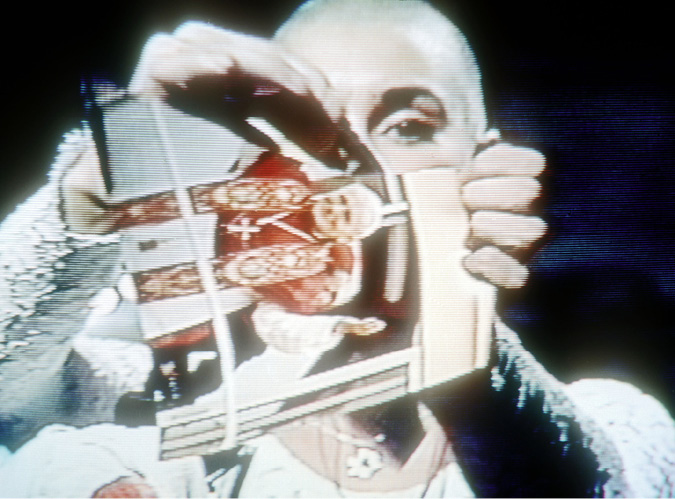
“Fight the real enemy!”: Irish singer Sinéad O’Connor shocked, surprised, and offended some Americans when she ended her rendition of “War” by tearing up a photograph of Pope John Paul II (18.2).
Photo by Yvonne Hemsey/Getty Images
The NBC switchboard immediately lit up. According to Variety, NBC logged more than 900 calls from people who did not like the show and seven who did. “It goes without saying that NBC does not condone what Ms. O’Connor did,” network vice president Curt Block told the Associated Press. “We would never authorize something like that. . . . I was offended; the executive producer, Lorne Michaels, likewise was offended and surprised.”
In Shales and Miller’s Live from New York, Michaels explains what he was focusing on that evening was not O’Connor, but what host Tim Robbins was wearing, namely an anti–General Electric T-shirt (GE was NBC’s parent company) he was planning to wear to protest GE’s pollution of the Hudson River. According to Michaels, he had even written a sketch about it, but it was never done. Instead, Robbins begins his monologue by telling the audience that GE doesn’t just make kitchen appliances and lightbulbs but triggering devices for nuclear warheads. Director Dave Wilson asks him to go backstage to talk to Lorne, who then wakes up in bed (with Phil Hartman!) and reveals Robbins’s monologue was only a dream.
As for O’Connor’s surprise, Lorne told Shales and Miller “it was the bravest possible thing she could do. . . . To her the church symbolized everything that was bad about growing up in Ireland . . . and so she was making a strong political statement.”
When asked for a statement, O’Connor’s spokesperson, Elaine Shock, said the singer did not plan to offer an explanation for her actions: “The performance makes her own statement. She relates a lot of the ills of the world to the church.” Americans who publicly agreed with O’Connor were in the minority. A dozen protestors and free-speech activists stood in front of St. Patrick’s Cathedral wearing Sinéad masks and tearing up pictures of the Pope. Those who were offended and outraged by what she did were vocal in their opposition. On SNL the following week (18.3), host Joe Pesci tore up a picture of O’Connor. A week later, on October 16, 1992, O’Connor was scheduled to sing in a sold-out concert in Madison Square Garden to celebrate Bob Dylan’s thirtieth-year anniversary on the singer/songwriter’s career. The list of performers included Eric Clapton, George Harrison, Johnny Cash, Willie Nelson, and Stevie Wonder. O’Connor was slated to sing Dylan’s “I Believe in You.” As she was being jeered and booed by the crowd, she started to sing Bob Marley’s “War,” but broke down in the middle. Kris Kristofferson came out onstage to comfort her.
In 2002, in a piece on for salon.com, Jake Tapper revisited the controversy and had a chance to sit down with O’Connor, who said, “It’s very understandable that the American people did not know what I was going on about. But outside of America, people did really know and it was quite supported and I think very well understood.” What Americans were in the dark about back then was how the Catholic Church in Dublin was protecting pedophile priests by reassigning them to other parishes. The irony, of course, is that since then, the sexual abuse scandals involving the Catholic Church did erupt in the United States. O’Connor said she “felt sad for the American people that they have to suffer such a shock.” Her feelings toward the Catholic Church and the Pope had also evolved since then. In April 1999, she was ordained the first-ever Latin Tridentine female Catholic Priest and given the name Mother Bernadette Marie. As for the man whose photograph she tore into tiny pieces in front of millions of people, she said, “Ripping up the picture was more about the office than the man. I don’t have a particular problem with him as a man or what he’s done as pope.”
Rage Against the Machine (Steve Forbes) (21.17)
A musical artist’s availability is limited due to his or her touring schedule, which is one of the primary factors when scheduling someone to appear on the show. Consequently, there have been some odd pairings over the years: Don Rickles and Billy Idol (9.11) (what do you think they talked about backstage?), Jeremy Irons and Fishbone (16.16), Sean Hayes and singer/rapper Shaggy (26.12), and Al Gore and Phish (28.8). In each case, the difference within each pair is either generational and/or a difference in their artistic sensibilities.
In the case of host Steve Forbes and Rage Against the Machine, the difference was not simply generational but ideological. Steve Forbes is a publishing magnate (his father was Malcolm Forbes) and a conservative who, at the time, was making his first unsuccessful bid for the Republican presidential nomination for the forthcoming 1996 election. The main plank of his political platform was the establishment of a flat tax, an idea he promoted in his monologue.
On the other end of the ideological spectrum is Rage Against the Machine, a rap metal band from Los Angeles whose music is an explicit expression of their leftist politics. In a flyer distributed by Kenny Moore, the Florida representative for “Rock Out Censorship,” RATM guitarist Tom Morello, stated that the band “wanted to stand in sharp juxtaposition to a billionaire telling jokes and promoting his flat tax . . . by making their own statement.” Before performing their first song, “Bulls on Parade,” SNL producers ordered stagehands to remove the upside-down flags hanging on their amplifiers. As Morello later explained, the inverted flags represented their “contention that American democracy is inverted when what passes for democracy is an electoral choice between two representatives of the privileged class. America’s freedom of expression is inverted when you’re free to say anything until it upsets a corporate sponsor.”
Once the band headed offstage, they were told they would not be playing again and they needed to leave the building now. RATM bassist was reportedly so angry he went into Forbes’s dressing room and threw shreds of one of the torn flags.
“SNL censored Rage, period,” Morello concluded. “They could not have sucked up to the billionaire more. The thing that is ironic is SNL is supposedly this cutting edge show, but they proved they’re bootlickers to their corporate masters when it comes down to it.”
Surely this was not one of SNL’s proudest hours.
By the way, Forbes was a terrible host, and there was no reason to have him on the show.
The Not Ready for Prime Time Singers
Ashlee Simpson (30.3)
Simpson was the victim of bad timing on several fronts. First, the week she appeared on the show, 60 Minutes’ Lesley Stahl and her film crew were spending time at 30 Rock doing a piece on how the show is put together. The first sign that there is a problem is at rehearsal when Simpson leaves the stage in tears worried, as Lorne Michaels tells Stahl, about losing her voice, and they weren’t sure if she should perform at the dress rehearsal before the show but instead save her voice for the broadcast.
During the live show, Simpson sang her first number, her hit single “Pieces of Me” without any problems. When it was time to do her second number, “Autobiography,” the vocal track for “Pieces of Me” was mistakenly played again. At the time, she was holding her microphone at her waist, so it was obvious the vocals were not coming from her lips. Uncertain what to do, a confused Simpson did a few dance steps, and walked off the stage. Her band continued to play “Pieces of Me.” According to Michaels, it was the first time in SNL history that a guest walked offstage during a live show. An additional episode of the comedy short Bear City aired, though Simpson did reappear at the end of the show with host Jude Law.
Jude Law: “What can I say, it’s live TV.”
Ashlee Simpson: “Exactly, I feel so bad, my band started to play the wrong song, and I didn’t know what to do, so I thought I’d do a hoe-down. I’m sorry. I didn’t mean for it to happen.”
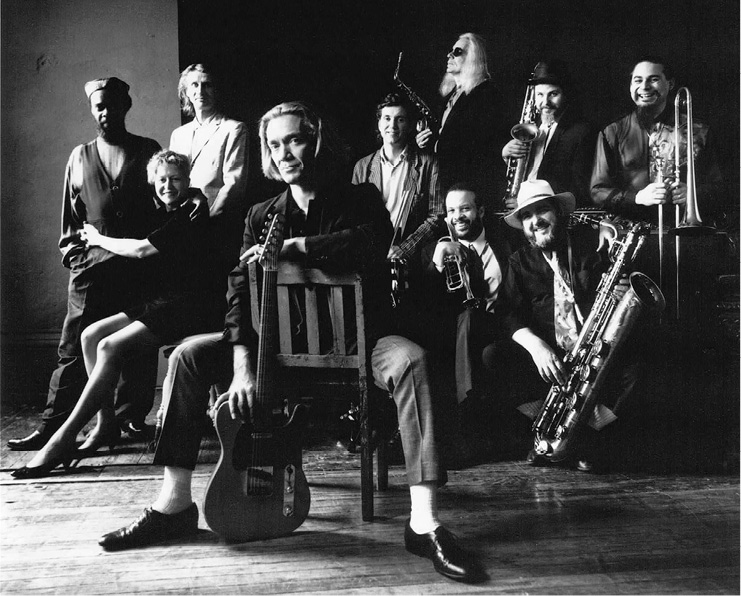
George Edward “G. E.” Smith (center, with guitar) and the Saturday Night Live band. Smith was the show’s musical director for ten years (1985–1995).
Michaels later confirmed that no one had discussed Simpson’s plans to lip-synch her performance. He explained that the only time he’s been aware of lip-synching “is during dance breaks where if it was all about dance, and that’s a relatively recent phenomenon.” Simpson’s father, Joe Simpson, later told the New York Times that he had made a call to Ashlee’s physician, Dr. Joe Sugerman, who confirmed that Ms. Simpson suffered from acid reflux and had woken with severe laryngitis last week. “I told her that she could really damage her vocal cords if she tried to sing.” But because SNL is a national show, Mr. Simpson insisted that she go on and use a recorded backing track. Unfortunately, the drummer accidentally started up the one for “Pieces of Me.”
If anyone benefited from the mishap, it was probably Simpson, who received the kind of national publicity you can’t buy. She even joked about it during a performance in Las Vegas when her band started to play “Pieces of Me” instead of “Autobiography.”
Simpson did return to the show the following season (31.2), singing “Catch Me When I Fall” and “Boyfriend” without incident.
The Ashlee Simpson debacle didn’t seem to put the kibosh on live lip-synching, as Eminem took to the stage the following week (30.4) and performed “Just Lose It,” which sounded as if it was recorded at another time and place, as the movement of his lips don’t correspond directly with the words coming out of his mouth.
To be fair, Simpson and Eminem are not isolated cases. Since the Simpson incident, viewers have been vigilant and continually report any suspicious on-air behavior online.
Lana Del Rey (37.12)
Prior to her appearance on Saturday Night Live on January 14, 2012 (37.12), Lana Del Rey did an interview with MTV News in which she said it was an “honor” to be asked to appear on SNL despite the fact that her album had not yet been released in the United States. This was not unprecedented. Natalie Imbruglia appeared on March 7, 1998, three days before her debut album, Left of the Middle, was released in the United States (it received three Grammy nominations and sold over seven million copies worldwide). Twenty-two-year-old Jessie J, a British R&B singer, was a star in Britain but relatively unknown in the United States when she made her debut in March 2011 (36.17), one month before the release of her solo debut album in America in April.
Del Rey’s debut single, featuring the two singles she sang on SNL—“Blue Jeans” and “Video Games”—was released on October 10, 2011. Both songs are on her second studio album, Born to Die, which was released on January 31, 2012, and debuted at #2 on the Billboard 200 Albums Chart. The homemade music video for her single “Video Games” had twenty-one million views on YouTube, and the song reached the Top 10 in the United Kingdom and other countries. Her performance of both songs on SNL was skewered by critics. She looked very uncomfortable in front of the camera. Her voice was shaky and her movements were slow and tentative. Wearing a peach-colored 1960s retro dress, she looked like she was trying to cultivate some sort of persona, but it was difficult to figure out what exactly she was going for. Del Rey’s performance caught the attention of the critics and the public—but not in a positive way. NBC News anchor Brian Williams e-mailed Nick Denton at Gawker, saying her performance was “one of the worst outings in SNL history” (Williams’s e-mail, according to NBC, was not meant to be public). Far more entertaining than her performance was Kristen Wiig’s parody of the singer the following week. She appeared on Weekend Update not to defend her performance (37.3), but to agree with all the criticism. She admits that people thought she was “stiff, distant, and weird” because she is “stiff, distant, and weird.”